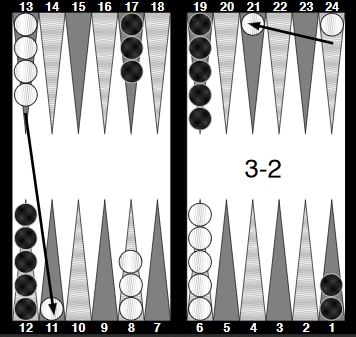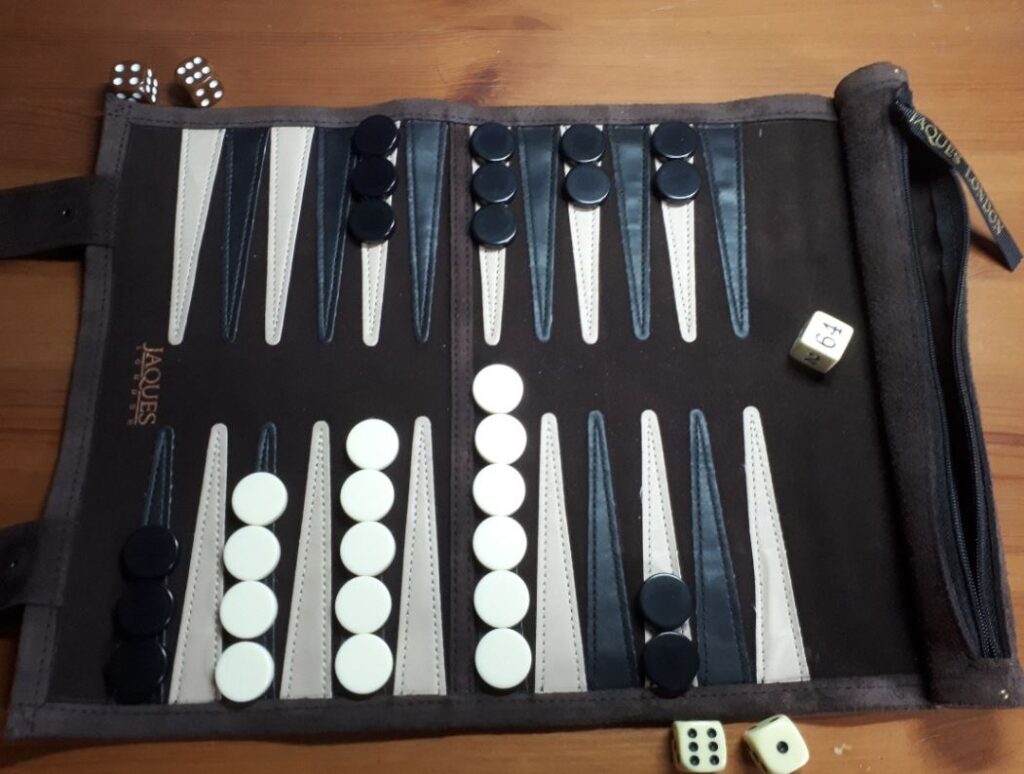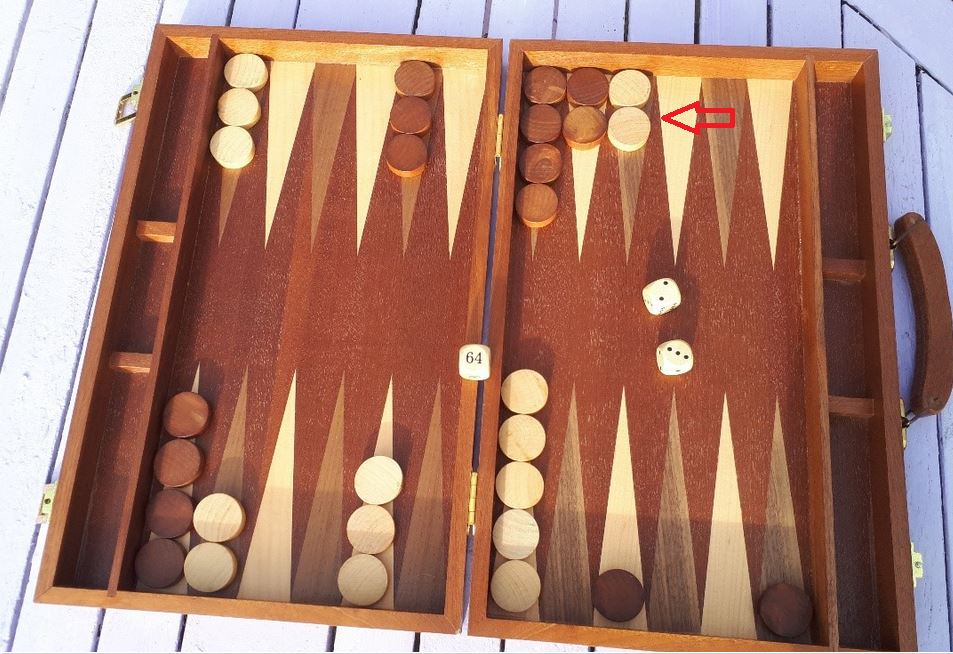Last updated on May 23, 2024
In this Deluxe Backgammon post for beginners, we examine some of the key strategies and concepts that need to be understood in order to win at backgammon. If these fundamentals are not understood winning at backgammon will be purely dependent on lucky rolls of the dice. It is much more satisfying to win when you know that you have played correctly and dynamically applied the correct strategies to achieve victory. Study the concepts below and you will learn how to win at backgammon.
Flexibility
An even distribution of checkers on the board is critical to provide the highest number of favourable moves for each dice roll. In backgammon, this is known as flexibility and it often creates the illusion of luck. Beginners are often reluctant to leave a blot, which typically results in the checkers being heavily stacked across a few points. This concentrated distribution leaves them with fewer options on subsequent dice rolls and plays are often forced. It is generally, a good idea to try and limit the stack to no more than four checkers where possible. A player with a good distribution will often appear to get lucky rolls because they are able to choose the best possible move from a variety of alternatives.
An example of a flexible move would be an opening roll of 3-2. Most beginners would move a checker from the mid-point to the 8-point. This is generally due to the fear of leaving a blot. It is a safe move. However, it leaves all of your checkers spread across only four points, which gives fewer options on the next roll. A better move is 24/21, 13/11. It leaves four blots, but these are relatively safe and give more starting points on subsequent rolls. The back checkers could be used to form an anchor and the checker on the 11-point is a useful builder.
Narrow distribution
Although distribution is important, it is also crucial to ensure that the spread of checkers is narrow. This means keeping your checkers within range of a single dice roll. Keeping them within six pips of each other maximises the chances of using them to secure key points. A wide separation of checkers leads to a weakened structure, which your opponent will exploit at the first opportunity.
For example, imagine you have two checkers 5 pips apart. There are 11 rolls out of 36 (31%) that allow a direct (single die roll) move. In addition, there are 4 rolls out of 36 (11%) that allow an indirect (the sum of both dice) move. Overall, this is a total of 15 rolls out of 36 (42%). Compare this to two checkers that are 8 pips apart. Obviously, there is no direct option for moves of 8 pips, so it requires the sum of both dice to reach the target. In this instance, there are only 6 rolls out of 36 (17%) that total 8. Clearly, the narrower distribution provides a greater chance of securing a point on subsequent moves.
Running game
If you manage to get good rolls early in the game and are able to escape your back checkers (for example, an opening roll of 6-5 followed by a 6-6) you should immediately consider the running game strategy. The high rolls provide an early advantage in the race, and by continuing to move your checkers forward as quickly as possible, you are hoping to maximise that advantage.
The running game is really only advised when you have a significant lead in order to determine this you need to be able to calculate the pip count. The rule of 8 can be used to determine how many rolls in front you are compared to your opponent. Running turns the game into a pure race, where your only objective is to move your checkers forward as quickly as possible. This creates an element of risk where blots may be hit. It only takes a couple of hit blots or low rolls to stop a running game in its tracks.
Risk
The reluctance to leave blots is a common mistake that many beginners make. The fear of being hit overrides any thought of creating flexible positions using narrow distribution. However, any experienced player will confirm that taking the risk and leaving blots is critical to win regularly at backgammon. However, you still need to carefully consider when and where to leave blots. Always, be careful when your opponent’s home board is strong. The more points that are secure in their home board, the more difficult it will be to re-enter.
Leaving shots early in the game involves less risk. This is because your opponent’s home board is relatively weak, with perhaps only the 6-point secure. However, if you have secured several points in your home board, you have the benefit of being able to play more aggressively.
Priming game
The priming game is a critical strategy that should be understood by all backgammon players if they want to progress beyond the level of a beginner. A prime is two or more adjacent secure points. This could be anywhere on the board, but is most effective in your home board. A six-prime creates an impassable barrier for your opponent’s back checkers. The ideal six-prime is one that occupies your entire home board making it impossible for your opponent’s checkers to re-enter from the bar.
A prime has several strategic advantages. Firstly, it provides a barricade that blocks your opponent’s checkers. Secondly, it provides a secure landing place for your own checkers. Finally, if the prime is in your home board it reduces the number of open points for your opponent to re-enter from the bar.
Back game
The back game is never a strategy of choice. It is a strategy of last resort, forced upon players who have been multiple times and are way behind in the race. This type of game should be reserved only for desperate situations. The chances of winning using the back game strategy are slim, but comebacks can occur if the dice roll your way. A back game strategy is initiated by establishing two or more defensive anchors in your opponent’s home board. The idea is to the points for as long as possible in the hope that your opponent leaves a blot when bearing off.
Whilst waiting for the opportunity to hit you should be simultaneously building a strong home board position. When the opportunity arises to hit, you should have a strong home board prime that will block re-entry or at least contain your opponent’s checker. Ideally, you would have closed the board with a six-prime. When the blot is hit, the idea is to contain it behind a prime and close out your opponent. A victory using the back game strategy can be satisfying as undoubtedly you will have come from well behind to win.
Anchoring
An anchor is one of the key strategic positions in backgammon. It simply means establishing a secure point in your opponent’s home board. This has several advantages. First, it provides a safe landing point for re-entry should one of your checkers be hit. Secondly, it restricts the ability of your opponent to create an effective home board prime. Lastly, it gives offensive options to strike at blots in the opponent’s outer board.
Ideally, you should try establishing anchors on the higher points 20 or 21 early in the game. These points are known as advanced anchors. If you find yourself significantly behind in the race, the lower points 22, 23 or 24 should be targeted for anchor placement as your strategy is to build your home board and wait for a shot. When playing this type of back game, two anchors on adjacent points provide a stronger structure than anchors set apart can be very functional.





All important points for backgammon beginners. Understanding the Risk and Flexibility paragraphs would be most beneficial for people new to backgammon. Too often I see beginners with a series of towers on their board. They then wonder why they are often forced to make unfavourable plays.